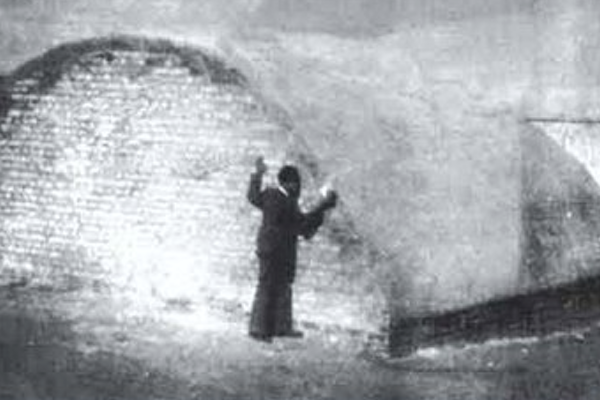My Parents' Survival Story Implies A Broader 'Intersectionality'

A mass grave for victims of the 1941 attack on the Jews of Baghdad
We recently observed the centennial anniversary of the destruction of Black Wall Street, the prosperous African-American community of Greenwood in Tulsa, Oklahoma, in 1921. A remarkably similar event was remembered by Jews of Iraqi origin, but not by many others. Exactly 20 years after the attack on Black Wall Street, on June 1st and 2nd, 1941, Iraqi Arabs, enraged by the British defeat of a pro-Axis uprising, descended upon the Jews of Baghdad to kill 200 or more, injure up to 2,000 and destroy 900 homes – an event known as the “Farhud,” Arabic for “violent dispossession.”
Historian Joshua Shanes convincingly argued that the Tulsa massacre was a “pogrom,” a term usually depicting large-scale mob violence against Jews. It resulted in the deaths of 300 Black people, the destruction of 1500 homes and businesses, and an entire community of survivors driven out and intimidated into decades of silence. New York Times columnist Jamelle Bouie has also used this term to describe Tulsa and similar mass atrocities against African-American communities.
Obviously, the Tulsa massacre is more significant for American history and for its present racial reckoning, but the Farhud pogrom is noteworthy for the remarkable coincidence in the calendar of these two parallel catastrophes, with defenseless minorities being victimized by violent mobs as agents of law enforcement either stood idly by, or aided, and sometimes even orchestrated, the attacks.
A month before the Farhud, my parents came through Baghdad as Polish-Jewish refugees with immigration visas to the U.S., received just in the nick of time from an unsympathetic U.S. consular official. He was following the directive of Assistant Secretary of State Breckinridge Long to delay and obstruct legal Jewish immigration to the United States – a story well documented by David Wyman, Rafael Medoff and other historians of the period. This official presented my parents with a "Catch 22" situation: They were told to obtain the transit visas before he would release the immigration visas already in his possession, even though they needed the U.S. documents to obtain the transit visas! Upon the advice of a helpful travel agent, my father hurdled this obstacle by obtaining Greek, Turkish, and British consular letters stating that transit would be granted automatically after seeing their American visas.
They were lucky to be departing from Belgrade, Yugoslavia, and not from their Polish hometown of Zurawno, shortly to be invaded by the Soviet Union, and then overrun by Nazi Germany. It’s hard to imagine my parents’ scenario for escape if ensnared by Poland’s double occupation at the start of World War II.
My parents had come to Belgrade in 1938 to assist my mother’s Tante Elsa, her newly widowed aunt, expelled from Vienna by the Nazis; once in Yugoslavia, they sought refuge anywhere outside of Europe that would have them – not an easy task. They left Belgrade days before the Germans invaded on April 6, 1941. After weeks of travel as part of a British-escorted convoy through Greece under attack, and by train and hired car through Turkey, they crossed the Tigris River into Iraq by mule, greeted by mounted Iraqi border police with one word: Yahud (Jew)?
They were treated well by the police commander, who spoke English with my father. But given that Iraq was resisting its status as a British protectorate, he refused to recognize their British-issued transit visas, replacing them with Iraqi papers. And he hired a car and driver to take them to the train station in Mosul, with strict orders on payment in Iraqi dinars. The driver was so intimidated by the commander that he insisted on dinars rather than US dollars; my father had to find a currency exchange in the Mosul bazaar, where he met a Jewish money-changer with whom he spoke Hebrew. This man’s son guided them to the train station for the trip to Baghdad, and then on to the port of Basra. My father recalled using his Hebrew again, conversing with the Jewish conductors on the train.
In Basra, they boarded a British troopship delivering soldiers to Iraq to counter the pro-German rebellion (led in part by the exiled Palestinian Mufti of Jerusalem, Hajj Amin al-Husseini). The ship reloaded with German and Italian POWs below and refugees like my parents and Tante Elsa above, before departing for Karachi, British India.
From Karachi they took a British passenger liner to Bombay (I still have their souvenir pith helmet), where they boarded an American liner, the President Harrison. They sailed on to Cape Town, Trinidad and New York, disembarking on June 16, 1941, days before the Nazis invaded the USSR and their shtetl in Galicia, where my father’s entire family and my mother’s parents perished.
One has to wonder what happened to the Iraqi Jews they encountered. The conductors would have lost their jobs in 1948, when Jews were thrown out of the civil service, including the railroad, during Israel’s war of independence and the Palestinian Nakba. They probably ended up in Israel with about 120,000 others, airlifted in Israel’s “Operation Ezra & Nehemia,” in 1951-52, or otherwise escaped via Iran. Several hundred thousand Jews of Iraqi origin live in Israel today; maybe three or four individuals are still alive in Iraq.
Progressives often ignore the history of Jews as an oppressed minority group, which is still targeted by white nationalist extremists and vulnerable to other threats, including from Arab nationalists and Islamists. This can be a difficult concept for people who see Jews as privileged and powerful, and Israel as only an oppressor, and not a place of refuge; as for Israel, half of my extended family owe their lives to its existence.
My parents’ experience made me acutely aware of the vulnerability of Jews. A more inclusive “Intersectionality” might have commemorated both pogroms in tandem, or at least been more aware of the parallels.